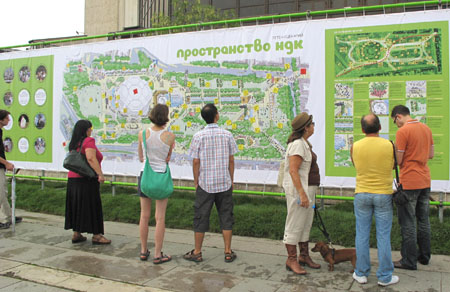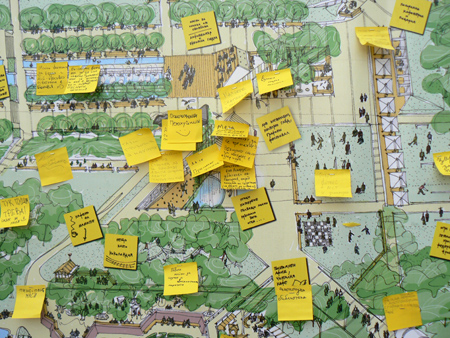A biweekly newsletter with public space news, resources, and opportunities.
A curated dispatch on all things public markets plus the latest announcements from the Market Cities Program.
My home country of Bulgaria has been through enormous social, political, and economic changes in the last 20 years. The end of communism, the rise of a democratic society, membership in the European Union – it has been an amazing, and sometimes difficult, transformation. A whole way of life has been replaced in the span of a generation, and that has meant both excitement and uncertainty.

As civil society has become more vibrant and the new social institutions have become more robust, people have begun to see the potential of their public spaces in a completely new way. There is a growing eagerness to make those places better. It’s a revelation for people to realize that they can take ownership of these places and make the change happen themselves.
I recently returned to my hometown, the capital city of Sofia, at the invitation of Architects for Sofia, an association of younger architects. They invited me to lead a series of discussions and workshops introducing local leaders, architects, designers, and planners to the theory and practice of Placemaking, and to begin developing a strategy for improving public spaces in the capital and for strengthening the network of public spaces in Sofia. (PPS activities in Sofia were supported by the Municipality of Sofia, the Sofia Development Association, the Chamber of Architects in Bulgaria, and industry partners.) The annual Johns Hopkins Conference of International Urban Fellows Association was also taking place in Sofia at the time, with a focus on the management of public spaces. It was a great chance to get a glimpse of where the city could be headed.
The public realm: It belongs to us For many years in the post-communist era, efforts to change cities were focused on “big” infrastructure, with public spaces and parks seen as a “fluffy” amenity that didn’t require immediate attention. But as Bulgaria has stabilized, that, too, has changed. Now ordinary people and professionals alike are seeing the potential and importance of public spaces, and asking how they can take an active part in making their cities more livable.

The architectural legacy of communism includes huge apartment blocks with surrounding green space whose ownership isn’t always clear. It is in these places that the first citizen-led and volunteer initiatives in Sofia sprang up. Some of the efforts are small-scale -- like parents who got together to plant gardens or repaint playground equipment (made out of Soviet tank steel, these Bulgarian playgrounds are one piece of public infrastructure that won’t break!). Larger groups have organized around issues such as improving conditions for bicycling.
Looking outward Bulgaria has always been a geographically provincial place, at the outer edge of one empire or another. And so change has come more slowly here than it has in the Soviet bloc countries of Central Europe, such as the Czech Republic, Poland, or Hungary.
But since Bulgaria joined the EU in 2007, the country has been looking outward more and improvement appears attainable. People can travel easily around Europe now. They see residents of cities around the world -- not just Paris, but also former communist capitals such as Budapest and Prague -- who feel pride in their places. They even see smaller towns around the country sprucing up their main streets and central parks to the delight of their citizens. And they ask themselves, why not in Sofia? A few years back the answers were: “It’s always harder in the big cities; people don’t care as much; they don’t feel ownership; the bureaucratic barriers are too great; and so on…”
Today things seem different. A younger generation, with almost no memory of “the old way” of doing things, is coming of age. Expatriates are returning from abroad, seeing their homeland as a place of opportunity for the first time. Even city councils and municipal governments seem to be poised for experiments and ready to do things differently in the public realm. Bulgaria’s citizens are coming to demand more of their government and a much higher quality of life in their cities. And they are ready to be a part of making it happen.

Professionals are also shifting their focus. After years of breakneck residential and commercial development fueled by the rapid privatization of the economy, there’s a renewed interest among architects and designers in the public realm, in part because that’s where the money is now. Urban planning as an independent academic discipline is young in Bulgaria — it’s only been around for 5 or 10 years as a field of study distinct from design and architecture. No longer the poor stepchild of architecture and social policy, the discipline has broken away from its dogmatic socialist past and is growing. Today, there’s a new crop of professionals who are young, energized, and ready to contribute their skills to improving their cities.
Using Placemaking to improve Sofia’s public spaces It’s that new generation of architects, designers, planners, landscape architects, artists and NGOs that fuels some of Bulgaria’s most promising experiments in Placemaking. Architects for Sofia, my partners on this trip, is a nonprofit created in May 2010 that advocates for great public spaces around the city. Their website, Sofia 2020, is dedicated to generating ideas from the public and from other architects about improving Sofia’s public built environment.
An important component of building a Placemaking strategy for Sofia was to conduct a demonstration Placemaking workshop in a prominent public space in order to show the potential of this methodology for eliciting ideas, building consensus and identifying “lighter, quicker, cheaper” improvements that could be implemented right away. On the second day of my visit, local planners, architects, landscape architects, sociologists, psychologists, artists, anthropologists, and journalists came together to brainstorm ideas and build a vision in a demonstration Placemaking workshop focused on one of the most central public spaces in Sofia – the plazas and park spaces surrounding the National Palace of Culture.
The ideas started popping up right away -- repurposing a derelict monument from the communist era into a place for rock-climbing and graffiti art; transforming a parking lot into an event area, complete with a carousel and games for kids; clearing up overgrown green areas and turning them into gardens, dog runs, and tot lots; refurbishing water fountains; replacing amenities; creating areas where youth and seniors mix and learn from each other; and many more.
Following the workshop, Architects for Sofia staged an outdoor exhibit in one of the discussed spaces and invited citizens to re-imagine all the places around the Palace of Culture. They created a huge and beautiful rendering of the ideas generated in the Placemaking workshop and then invited people to leave their comments and suggestions directly on the plan. (The place where the map was hanging was actually on the map itself.) The Bulgarian National News Agency covered the exhibit, a sign of changing attitudes toward public participation in the planning process.

The exhibit is just a first step in demonstrating the benefits and potential for Placemaking in Sofia. I am hoping to return soon to help with developing an implementation plan for some of the ideas that came out of this very public process, and to continue a discussion about the best practices and most appropriate models for managing important public spaces in Sofia. Among the ideas we hope to pursue with city council members and municipal administrators is the concept of establishing a conservancy or nonprofit association to manage, program, maintain and develop the public spaces of the Palace of Culture.
As we gear up for this continued effort, one thing has becomes clear: The people of Sofia are ready to make a better city for themselves -- not an imitation of other European capitals, but an authentically Bulgarian great place.
The rich text element allows you to create and format headings, paragraphs, blockquotes, images, and video all in one place instead of having to add and format them individually. Just double-click and easily create content.
The rich text element allows you to create and format headings, paragraphs, blockquotes, images, and video all in one place instead of having to add and format them individually. Just double-click and easily create content.
Body Text Body Link
The rich text element allows you to create and format headings, paragraphs, blockquotes, images, and video all in one place instead of having to add and format them individually. Just double-click and easily create content.
Here is some highlighted text from the article.




Headings, paragraphs, blockquotes, figures, images, and figure captions can all be styled after a class is added to the rich text element using the "When inside of" nested selector system.
Headings, paragraphs, blockquotes, figures, images, and figure captions can all be styled after a class is added to the rich text element using the "When inside of" nested selector system.
Headings, paragraphs, blockquotes, figures, images, and figure captions can all be styled after a class is added to the rich text element using the "When inside of" nested selector system.